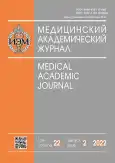Surface expression of SARS-CoV-2 epitopes in Enterococcus faecium L3 for live oral vaccine against new coronavirus infection
- Authors: Kopteva O.S.1,2, Desheva Y.A.1,2, Ivanova A.N.2, Vorobyov M.G.2, Leontieva G.F.1, Gupalova T.V.1, Bormotova E.A.1, Suvorov A.N.1,2
-
Affiliations:
- Institute of Experimental Medicine
- Saint Petersburg State University
- Issue: Vol 22, No 2 (2022)
- Pages: 197-202
- Section: Conference proceedings
- URL: https://bakhtiniada.ru/MAJ/article/view/108671
- DOI: https://doi.org/10.17816/MAJ108671
- ID: 108671
Cite item
Abstract
BACKGROUND: Probiotic microorganisms are currently considered as a promising platform for the development of recombinant vaccines expressing viral or bacterial antigens. Probiotic-based mucosal vaccines are easy to produce in large quantities, they have a low cost, provide a fairly long T-cell memory.
AIM: The aim was to study expression of mRNA fragment of S1 SARS-CoV-2 gene in Enterococcus faecium L3 culture and to confirm the insertion of S1 SARS-CoV-2 protein fragment into the pili of this bacterial strain by immunoelectron microscopy of original (E. faecium L3) and genetically modified strain (L3-SARS) with human sera obtained from patients with SARS-CoV-2.
MATERIALS AND METHODS: mRNA expression was studied by real-time PCR with reverse transcription using primers specific to S1 protein. Immunoelectron microscopy was aimed to study the structure of E. faecium L3 pili with the expression of viral protein SARS-CoV-2. Bacteria were washed three times in PBS by centrifugation at 3500 rpm for 20 min and suspended in 0.1 M NaCl. A 10-fold bacterial concentrate was used. The source of the primary antibodies was a set of polyclonal human sera containing IgG. Labeling was performed using goat IgG conjugated with 18 nm gold particles.
RESULTS: A sharp increase in mRNA amplification of inserted genetic sequence of S1 SARS-CoV-2 gene fragment relatively to the control was demonstrated. These results confirmed that DNA of S1 gene in E. faecium L3 genome is transcribed together with the target pili gene in E. faecium genome. Specific antigens of SARS-CoV-2 on the surface of L3-SARS were determined using electron microscopy, which demonstrated the correct assembly of chimeric molecules of pili on the surface of bacteria.
CONCLUSIONS: Evaluation in expression of SARS-CoV-2 S1 protein after introduction of the corresponding genetic elements into genome of probiotic strain E. faecium L3 allows us to conclude that selected DNA fragments of SARS-CoV-2 were able to direct the synthesis of immunogenic protein S1 that was expressed by the strain E. faecium L3-SARS.
Keywords
Full Text
##article.viewOnOriginalSite##About the authors
Olga S. Kopteva
Institute of Experimental Medicine; Saint Petersburg State University
Author for correspondence.
Email: olga.s.kopteva@yandex.ru
ORCID iD: 0000-0002-2645-3433
SPIN-code: 7630-3067
Scopus Author ID: 57354051000
Research Associate of the World-class Research Center “Center for Personalized Medicine”; Postgraduate Student
Russian Federation, Saint Petersburg; Saint PetersburgYulia A. Desheva
Institute of Experimental Medicine; Saint Petersburg State University
Email: desheva@mail.ru
ORCID iD: 0000-0001-9794-3520
SPIN-code: 4881-3786
Scopus Author ID: 9939567500
ResearcherId: I-1493-2013
MD, Dr. Sci. (Med.), Leading Research Associate of the World-class Research Center “Center for Personalized Medicine” and Leading Research Associate of the Virology Department; Professor of the Department of Fundamental Problems of Medicine and Medical Technologies of the Faculty of Dentistry and Medical Technologies
Russian Federation, Saint Petersburg; Saint PetersburgAlexandra N. Ivanova
Saint Petersburg State University
Email: alexandra.ivanova@spbu.ru
SPIN-code: 4486-1658
Cand. Sci. (Biol.), Specialist in Sample preparation for Transmission Electron Microscopy of the Resource Center “Development of Molecular and Cellular Technologies”
Russian Federation, Saint PetersburgMaxim G. Vorobyov
Saint Petersburg State University
Email: vorobiev.maxim@spbu.ru
Specialist in Transmission and scanning electron microscopy of the Resource Center “Development of Molecular and Cellular Technologies”
Russian Federation, Saint PetersburgGalina F. Leontieva
Institute of Experimental Medicine
Email: galeonte@yandex.ru
SPIN-code: 5204-9252
Cand. Sci. (Biol.), Senior Research Associate of the World-class Research Center “Center for Personalized Medicine” and Senior Research Associate of the Molecular Microbiology Department
Russian Federation, Saint PetersburgTatiana V. Gupalova
Institute of Experimental Medicine
Email: tvgupalova@rambler.ru
SPIN-code: 1242-3540
Dr. Sci. (Biol.), Leading Research Associate of the World-class Research Center “Center for Personalized Medicine” and Leading Research Associate of the Molecular Microbiology Department
Russian Federation, Saint PetersburgElena A. Bormotova
Institute of Experimental Medicine
Email: bormotovae@rambler.ru
SPIN-code: 7962-0043
Cand. Sci. (Biol.), Research Associate of the World-class Research Center “Center for Personalized Medicine” and Research Associate of the Molecular Microbiology Department
Russian Federation, Saint PetersburgAlexander N. Suvorov
Institute of Experimental Medicine; Saint Petersburg State University
Email: suvorov.an@iemspb.ru
SPIN-code: 8062-5281
MD, Dr. Sci. (Med.), Professor, Corresponding Member of the Russian Academy of Sciences, Head of the Microbial Therapy Department of the World-class Research Center “Center for Personalized Medicine” and the Head of the Molecular Microbiology Department; Head of the Department of Fundamental Problems of Medicine and Medical Technologies of the Faculty of Dentistry and Medical Technologies
Russian Federation, Saint Petersburg; Saint PetersburgReferences
- Mohseni AH, Taghinezhad-SS, Keyvani H. The first clinical use of a recombinant lactococcus lactis expressing human papillomavirus type 16 E7 oncogene oral vaccine: a phase i safety and immunogenicity trial in healthy women volunteers. Mol Cancer Ther. 2020;19(2):717–727. doi: 10.1158/1535-7163.MCT-19-0375
- Suvorov A, Gupalova T, Desheva Y, et al. Construction of the enterococcal strain expressing immunogenic fragment of SARS-CoV-2 virus. Front Pharmacol. 2022;12:807256. doi: 10.3389/fphar.2021.807256
- Gupalova T, Leontieva G, Kramskaya T, et al. Development of experimental pneumococcal vaccine for mucosal immunization. PloS one. 2019;14(6):e0218679. doi: 10.1371/journal.pone.0218679
- Khare B, Narayana SVL. Pilus biogenesis of gram-positivebacteria: roles of sortases and implications for assembly. Protein Sci. 2017;26(8):1458–1473. doi: 10.1002/pro.3191
- Montealegre MC, Singh KV, Somarajan SR, et al. Role of the Emp pilus subunits of Enterococcus faecium in biofilm formation, adherence to host extracellular matrix components, and experimental infection. Infect Immun. 2016;84(5):1491–1500. doi: 10.1128/IAI.01396-15
Supplementary files







